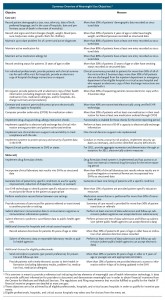 “We are only as good in treating patients as the information we have,” opined Dr. David Blumenthal, the national coordinator for health information technology in the Department of Health and Human Services, during yesterday’s launch of the new regulations on the meaningful use (MU) of health information technology.
“We are only as good in treating patients as the information we have,” opined Dr. David Blumenthal, the national coordinator for health information technology in the Department of Health and Human Services, during yesterday’s launch of the new regulations on the meaningful use (MU) of health information technology.
In the health care world, yesterday featured a star-studded line-up (live and via webcast) that ushered in the long-awaited meaningful use regulations that provide the roadmap for the adoption of electronic health records (EHRs) for providers, hospitals and doctors alike. Simultaneously, Dr. Blumenthal’s 4-page summary of the reg’s was featured in a tidy, useful article in the New England Journal of Medicine (a good primer for quick-study).
The reg’s break out into two categories: 15 must-dos, termed the “Core Set,” and a choice of 10 others (a “Menu Set” of 8 common options for doctors and hospitals, and 2 additional choices for docs and 2 for hospitals). Providers must choose 5 of these 10 to meet MU criteria, along with the mandatory Core Set, to qualify for receiving the incentive funds from the $20+ billion worth of monies included in the HITECH Act.
The Core Set include:
- Patient demographics
- Vital signs and chart changes
- Problem lists of current and active diagnoses
- Medication lists
- Medication allergy lists
- Smoking status
- Providing patients with clinical summaries for office visits by doctors, and for hospitals, providing an electronic copy of hospital discharge instructions when requested by the patient
- Providing patients electronic copies of their health information when requested
- E-prescribing
- Computer provider order entry for medication orders in hospitals
- Drug-drug and drug-allergy interaction checks
- Electronic exchange of key clinical information between providers and patient-authorized entities
- Clinician decision support rules and ability to track compliance with rules
- Protect privacy and security of patient data in an EHR.
There are measures and fine print under each of these. For example, regarding CPOE, it must be done for over 30% of patients with at least one medication. Thus, no objective in the Core Set of measures has to be accomplished for 100% of patients, 100% of the time.
Meaningful use is thereby a journey, not a destination, in Year 1 (2011-2012).
Health Populi’s Hot Points: The ultimate meaning of meaningful use is about patients getting the best care they need in the right place at the right time. The ultimate cautionary tale that teaches us why this isn’t just sound public policy, but also the moral pathway, is the story of Regina and Fred Holliday. On March 27, 2009, Regina’s husband, Fred, was diagnosed with renal cell carcinoma. Regina began to use the internet for information and support. Fred was in the hospital for a few weeks when, in April, Regina asked for a copy of his medical records. The medical records staff told Regina that would be 73 cents a page and a 21 day wait. The next day an oncologist told Fred and Regina the care team decided to send Fred home with a PCA pump. Regina and Fred were frustrated at every turn as his health information was not made available to them to enable them to make decisions on their own behalf.
Fred died on June 17th, 2009.
I urge you to read Regina’s Medical Advocacy Blog on an ongoing basis when the meaning of meaningful use fades into the background.
There are many lessons for all of us in health care to take from her and Fred’s story, from the lack of coordinated care to the question of who owns a patient’s data. When you get frustrated with hundreds of pages of regulations, and wonder why this important, remember it’s about better care and better access to health information for those who need it most: providers at the point of care, and patients and their loved ones in moments of truth, life and death.




 I'm in amazing company here with other #digitalhealth innovators, thinkers and doers. Thank you to Cristian Cortez Fernandez and Zallud for this recognition; I'm grateful.
I'm in amazing company here with other #digitalhealth innovators, thinkers and doers. Thank you to Cristian Cortez Fernandez and Zallud for this recognition; I'm grateful. Jane was named as a member of the AHIP 2024 Advisory Board, joining some valued colleagues to prepare for the challenges and opportunities facing health plans, systems, and other industry stakeholders.
Jane was named as a member of the AHIP 2024 Advisory Board, joining some valued colleagues to prepare for the challenges and opportunities facing health plans, systems, and other industry stakeholders.  Join Jane at AHIP's annual meeting in Las Vegas: I'll be speaking, moderating a panel, and providing thought leadership on health consumers and bolstering equity, empowerment, and self-care.
Join Jane at AHIP's annual meeting in Las Vegas: I'll be speaking, moderating a panel, and providing thought leadership on health consumers and bolstering equity, empowerment, and self-care.